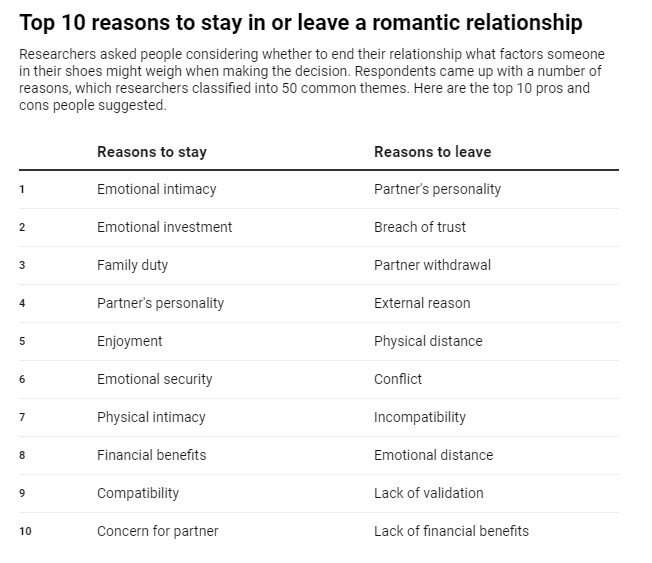Romantic relationships can be a blast and bring true happiness — but they can also turn sour. And although we may not like to agree with this, when that happens, many people will start re-evaluating their relationship status.
But when it comes to big decisionswhat exactly makes us stay, and what makes us want to leave? New research is taking a look at the factors that help us decide when a relationship has run its course, and how our estimations of which factors are important shifts over time.
To be, or to break up?

Understanding the forces that can pull us apart from or towards that special someone can help us improve the quality of our romantic relationships. With that in mind, it’s a sad reality of life that some relationships won’t stand the test of time, and if push comes to shove, you should never be ashamed of getting a divorce.
Previous research has found that there are a few elements most people tend to consider when deciding to break up (or not). For example, one study that asked people about these reasons found 50 common elements across 400 participants. Out of these, 27 were broadly in favor of staying, and 23 were generally in support of ending the relationship.
As for staying, most arguments focused on attraction to one’s partner, physical and emotional intimacy, and perceived high levels of support from the relationship. How much time and effort had been invested in one’s partner could also be a reason to stay (people were reluctant to ‘let it go to waste’), and they were also afraid of being alone after the breakup. How much fun you had as a couple, desirable traits in their personalities, how well you got on with their family, and healthy finances were also in support of staying.
As for cutting ties, the team listed many of the same issues, but seen through a negative lens. A partner’s problematic personality traits, a lack of communication or intimacy, lack of perceived support, and especially acts of infidelity or deception were all seen as signs a relationship has run its course.

A follow-up experiment with 200 participants who were thinking about breaking up or getting a divorce (part of the same study) found that around half of them reported feeling more inclined to stay in the relationship, even if it was troubled. The team takes this as a sign that the inertia of staying in an established relationship is quite strong. They support this view by adding that these same participants had an above-average inclination to leave — meaning that even if they reported wanting to continue the relationship, they also rated themselves as wanting to leave that particular partner.
This ambivalence, the authors say, is extremely common — both in their participants and in society at large. Relationship doubts are common, but most people are conflicted regarding how to act on them. Better understanding the factors that matter when making that decision (and which matter most) can thus help us make the right choice in our romantic lives as well, they add. Or at least, we can hope!
One of the most important findings of the research is that our feelings regarding romantic relationships are rarely clear-cut; instead, they ebb and flow subtly over time.
Another study interviewed 464 participants in stable relationships how serious these were every eight months. These ratings ranged from 0% to 100%, and asked the participants how confident they were that they will marry their partner (with 0% being “never thought about marriage” and 100% meaning “certain they would marry their partner in the future”). Each time their “commitment to wed” percentage changed from one interview to the next, researchers asked why.
All in all, the team logged about 13,598 such fluctuations during the experiment. These boiled down to around 14 root causes. In order of importance, these were negative or positive characteristics of the partner and relationship, direct statements of the partners or relationship (“they were considerate and kind” ,”we were drifting apart”), followed by circumstances — unforeseen events such as job loss, illness, or the need to move. These causes could take on a positive or negative nature, with positive ones unsurprisingly leading to increased commitment.
This, the authors explain, shows that relationships are influenced by internal elements, but outside ones also do have a role to play in making or breaking them. Still, the single most reliable indicator of whether a couple would break up or not: cheating. Other factors seem to have different importance for varying individuals, but cheating was virtually always a deal-breaker.
On the other end of the scale sits positive disclosure, the sharing of information among partners that foster positive feelings. Sharing good news, or stories that help your partner understand you better are all examples of positive disclosure.
The paper “Wanting to Stay and Wanting to Go: Unpacking the Content and Structure of Relationship Stay/Leave Decision Processes” has been published in the journal Social Psychological and Personality Science.


